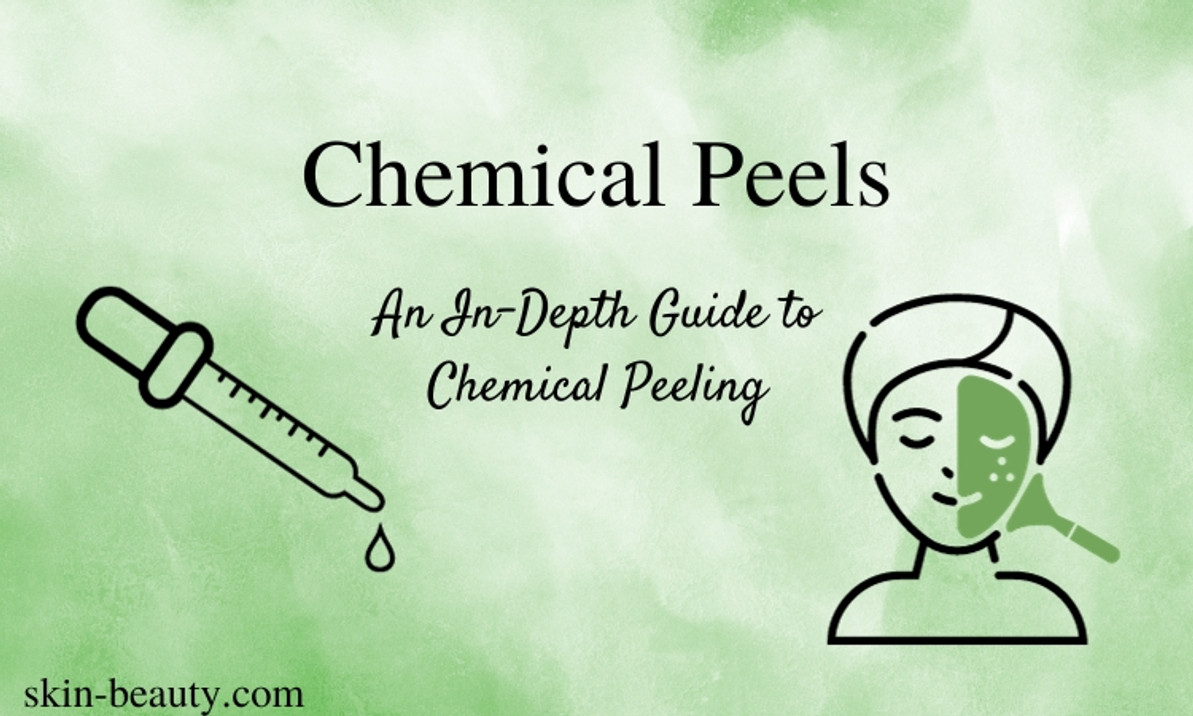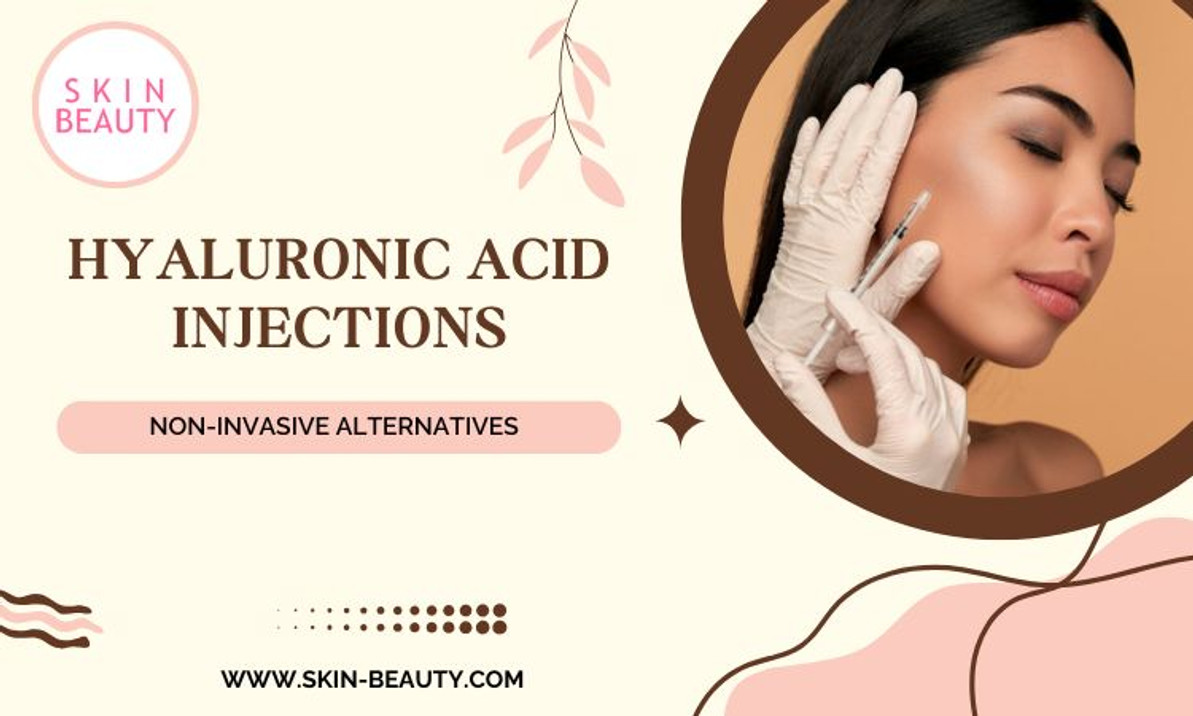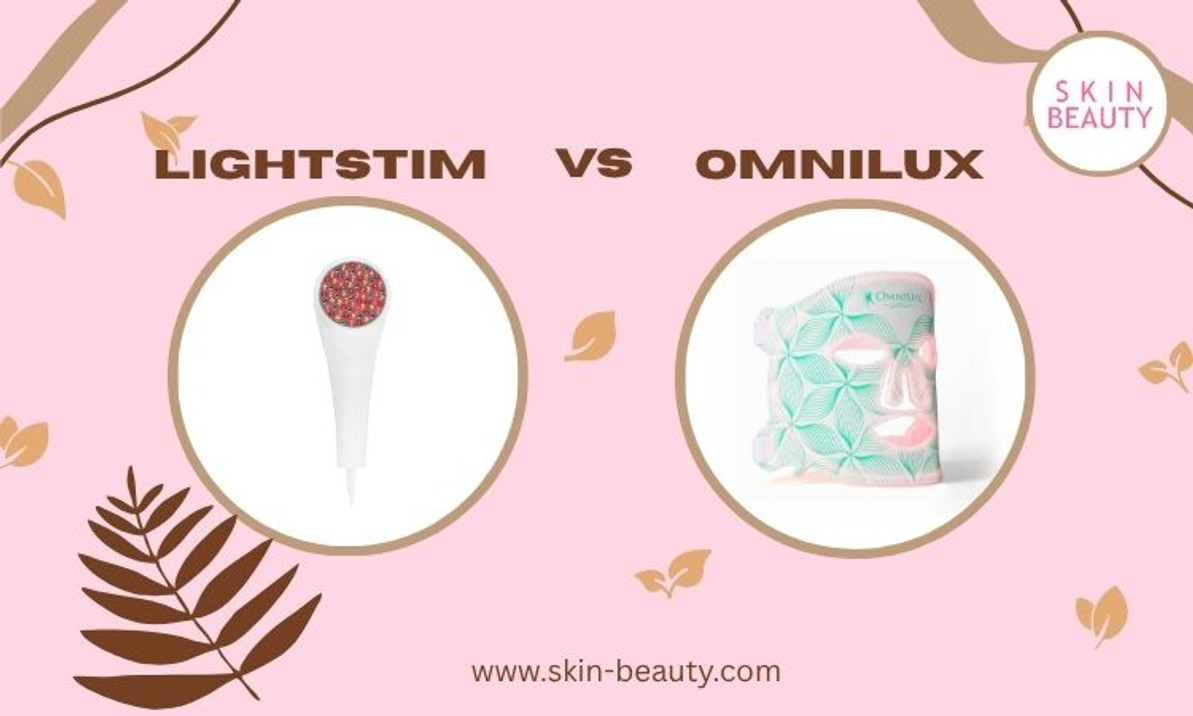Chemical Peeling
An In-Depth Guide to Chemical Peeling
Are you looking for a way to rejuvenate your skin and achieve a radiant, youthful glow? Chemical peeling might be the answer you’re seeking. This popular cosmetic treatment uses chemical solutions to remove damaged skin layers, revealing smoother, healthier skin underneath. In this comprehensive guide, we’ll explore the ins and outs of chemical peeling, from the science behind it to the different types and how to choose the right one for your skin.
Key Takeaways
- Chemical peels are a customizable and effective skin rejuvenation solution with many benefits.
- Tailor chemical peels to individual needs for best results, or compare them to other cosmetic treatments.
- Chemical peels can provide visible results in weeks without being painful or offering an instant fix.
Understanding Chemical Peels
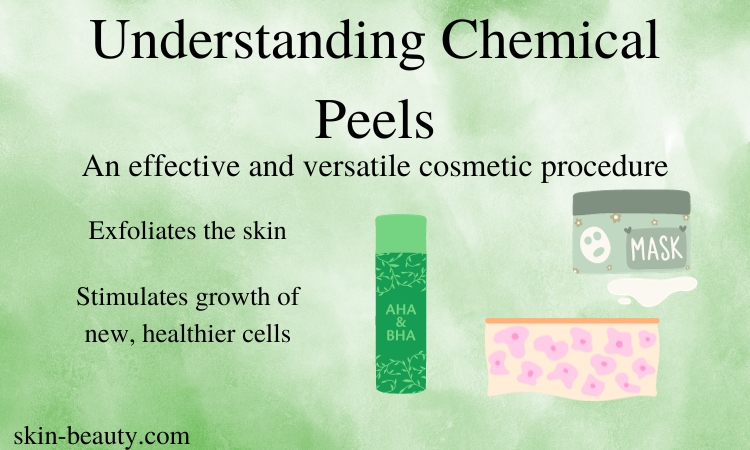
Chemical peels are an effective and versatile cosmetic treatment that uses chemical solutions to gently remove damaged skin layers, uncovering smoother and more youthful skin beneath. These treatments can range from a superficial, light peel to a deep peel and can address a variety of skin concerns, such as sun damage, wrinkles, and acne scars.
Whether you’re looking for superficial chemical peels for a quick skin refresher or a more intensive treatment to tackle challenging skin conditions, chemical peels can be customized to suit your needs.
The Science Behind Chemical Peels
The magic of chemical superficial peels lies in their unique ability to exfoliate the skin and remove damaged skin cells, creating controlled damage that stimulates the growth of new, healthier cells. This process is achieved through the application of specific caustic agents, such as glycolic acid or salicylic acid, which thin the outer layer of the skin and promote regeneration. Glycolic acid, an alpha hydroxy acid derived from sugar cane, is a celebrated and reliable superficial peeling agent with the smallest and simplest chemical structure of all alpha hydroxy acids.
As the chemical agent is applied to the skin, it creates a “white frost” – a helpful clinical indicator of peel depth and a useful marker of the duration of exposure. The depth of the peel varies depending on the desired results and the type of acid used, making chemical peels a highly customizable and effective skin rejuvenation solution.
Benefits of Chemical Peels
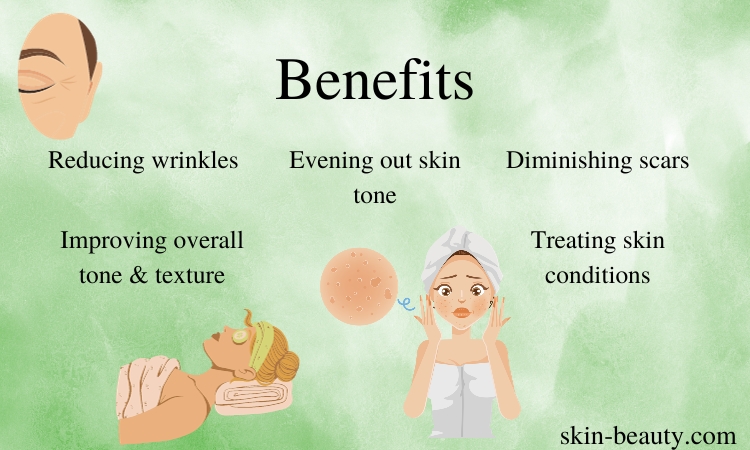
Chemical peels offer numerous advantages, such as:
- Reducing wrinkles
- Evening out skin tone
- Diminishing scars, typically on the face
- Treating certain skin conditions like acne and hyperpigmentation
- Improving the overall tone and texture of the skin
With benefits like smoother skin texture, improved skin tone, and a more youthful appearance, it’s no wonder chemical peels are a popular choice for skin rejuvenation.
It should be noted that temporary side effects such as:
- redness
- tightness
- irritation
- swelling
are common. However, with appropriate care and precautions, these side effects from skin resurfacing chemical peels can be mitigated. Ultimately, the benefits of chemical peels far outweigh the temporary discomfort, leaving you with healthier, more radiant skin.
Classifying Chemical Peels
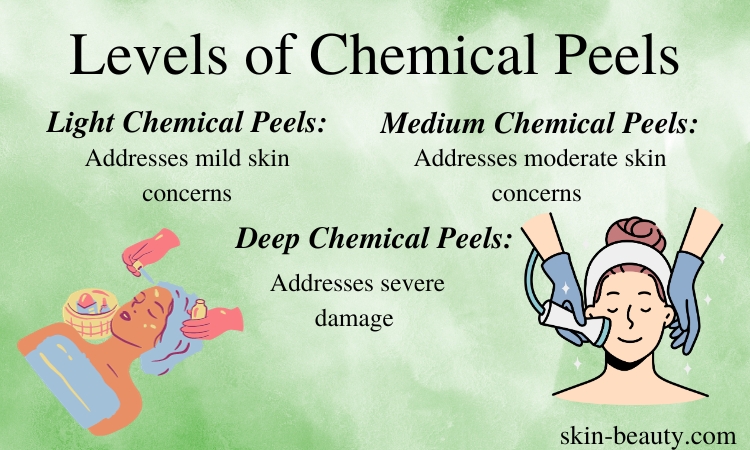
Chemical peels are divided into three categories based on their depth and strength: light, medium, and deep peels. Each type of peel offers unique benefits and addresses different skin concerns.
Light chemical peels are ideal for treating superficial skin issues with minimal downtime and recovery, while medium chemical peels target moderate skin concerns and require a longer recovery period.
Deep chemical peels, also known as deep peel treatments, are the most powerful type, used for severe skin damage, and necessitate an extended recovery time.
Light Chemical Peels
Light chemical peels use mild acids, such as glycolic or salicylic acid, to treat superficial skin issues, providing a quick solution with minimal downtime and recovery. These light peels are perfect for addressing mild acne or uneven skin tone and imparting a natural glow to the skin.
After a light chemical peel, the treated skin will appear smoother, brighter, and more even-toned. New skin might temporarily be lighter or darker than normal, but this usually evens out over time. Light chemical peels can be done regularly every two to five weeks, with treated areas typically healing within one to seven days.
Medium Chemical Peels
Medium chemical peels delve deeper into the skin layers, addressing moderate skin concerns like sun damage, deeper lines, and wrinkles. The most popular chemical agents for medium-depth peeling are 70% glycolic acid and 35 to 50% trichloroacetic acid (TCA), often combined with adjuvant combination products such as Jessner’s solution or solid carbon dioxide.
- To facilitate recovery, here are some recommendations:
- Stay out of the sun
- Use the solution prescribed by the dermatologist
- The dermatologist may also recommend an antiviral medication to help the healing process
Treated areas typically heal within 7 to 14 days, and you can start wearing makeup again in just 5 to 7 days.
Deep Chemical Peels
Deep chemical peels are the most aggressive type of chemical peel, intended for treating severe skin damage and allowing for thorough recovery. Patients with moderate-to-severe chrono- and photoaging, deep-furrowed rhytides, and/or significant hyperpigmentation are ideal candidates for deep peeling procedures.
After a deep chemical peel, you’ll likely experience a dramatic improvement in your skin’s texture and tone, as well as a reduction in wrinkles and other signs of aging. You may experience some temporary redness and swelling, but these should subside shortly. Deep peels are typically more intensive than other treatments. Therefore, they take around 14 to 21 days to fully heal.
Chemical Peel Procedures
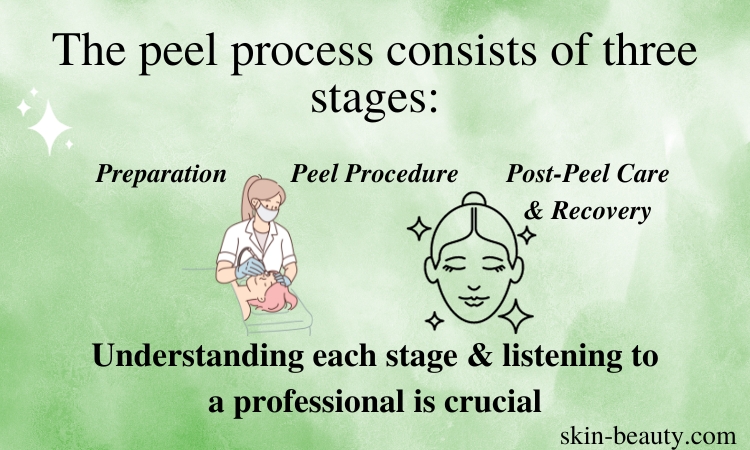
The chemical peel process is straightforward, comprising three stages: preparation, the peel procedure, and post-peel care and recovery. To achieve successful results, understanding each stage and adhering to the guidance of a qualified professional is crucial.
Preparing for a Chemical Peel
Preparing for a chemical peel involves:
- Consulting with a qualified professional, such as a dermatologist or dermatologic surgeon, to ensure a successful outcome.
- Choosing the most appropriate peel for your skin type, desired results, and medical history.
- Considering your skin type and the severity of your skin condition is an important part of the preparation process.
Besides choosing the correct peel, adhering to any pre-treatment guidance given by your skincare professional is also crucial. This may include avoiding certain medications, applying specific skincare products, or staying out of the sun in the weeks leading up to the procedure.
During the Chemical Peel
During the chemical peel, the chosen solution is applied to the skin, with the depth and duration of the peel varying based on the type of peel used. As the chemical solution is applied, you may experience a slight pleasant burning or tingling sensation, but it usually subsides quickly.
The duration of the peel varies depending on the type of acid used and the desired results, making chemical peels a highly customizable and effective skin rejuvenation solution. Once the peel is complete, the solution is rinsed off, and a soothing ointment or moisturizer may be applied to nourish and protect the treated skin.
Post-Peel Care and Recovery
Adhering to your doctor’s instructions for sun safety, cleansing, moisturizing, and applying dressing ointments post-chemical peel is crucial. Non-compliance can result in severe skin damage. Additionally, it is important to avoid picking, rubbing, or scratching your skin, as this can lead to scarring or infection.
Protecting your skin from the sun is essential for a healthier and brighter complexion. Here are some tips to help you achieve this:
- Wear a broad-spectrum sunscreen with an SPF of 30 or higher
- Wear a wide-brimmed hat when outdoors
- Avoid direct sun exposure for at least two weeks after a chemical peel
Following these tips will help protect your skin from the harmful effects of the sun and maintain a healthy complexion.
Choosing the Right Chemical Peel for Your Skin
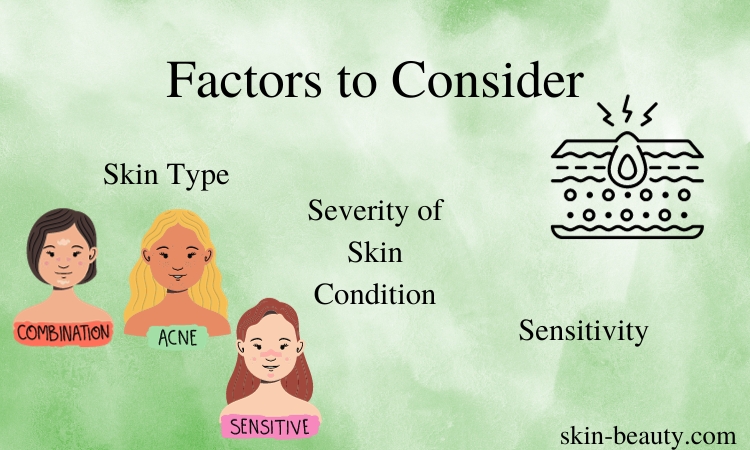
Selecting the perfect chemical peel for your skin involves considering factors such as skin type, desired results, and specific skin conditions. By understanding these factors and working with a qualified professional, you can ensure that you choose a peel that will effectively address your skin concerns and provide the best possible outcome.
Factors to Consider
When deciding on a chemical peel, considering factors such as your skin type, sensitivity, and the severity of the skin condition is necessary. Some important factors to consider are:
- Skin type: This includes dry, oily, or combination skin. Different chemical peels may be more suitable for different skin types.
- Sensitivity: If you have sensitive skin or conditions like rosacea or eczema, you may need to choose a chemical peel that is gentle and suitable for sensitive skin.
- Severity of the skin condition: The severity of your skin condition, such as acne or hyperpigmentation, may also influence the type of chemical peel that is most appropriate for you.
By taking these factors into consideration, you can make an informed decision and choose the best chemical peel for your specific needs.
Other factors to consider include the desired intensity of the peel and your medical history. The intensity refers to the strength of the chemical peel, which can range from light to very strong. Your medical history, including any past or current medical conditions, may also affect the outcome of the chemical peel.
Tailoring Chemical Peels to Skin Conditions
To effectively address specific skin concerns, it’s important to tailor chemical peels by carefully selecting the peel depth and acid type. To achieve beautiful results, chemical peels use a variety of acids, such as:
- glycolic acid
- lactic acid
- salicylic acid
- trichloroacetic acid
The exfoliation process for chemical peels involves applying the acid to the skin and allowing it to penetrate the skin. The depth of the peel depends on the type of acid used and the desired results, making chemical peels a highly customizable and effective skin rejuvenation solution.
By tailoring the peel to your specific skin condition, you can ensure that you receive the best possible treatment for your unique needs.
Comparing Chemical Peels to Other Cosmetic Treatments
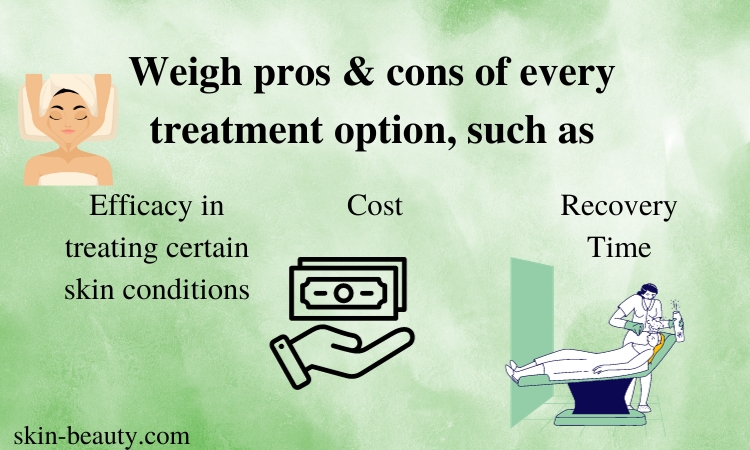
While chemical peels are an effective and popular choice for skin rejuvenation, it’s worth noting that there are alternative cosmetic treatments available, such as laser therapy and microdermabrasion. In terms of efficacy, chemical peels can be remarkably effective compared to other cosmetic treatments in treating certain skin conditions.
However, weighing the pros and cons of each treatment option based on cost and recovery time is crucial. Chemical peels can be a cost-effective alternative to other cosmetic treatments like laser therapy and microdermabrasion. Moreover, chemical peels generally require less recovery time than other treatments, making them an appealing option for those seeking quick and effective skin rejuvenation.
Common Misconceptions About Chemical Peels
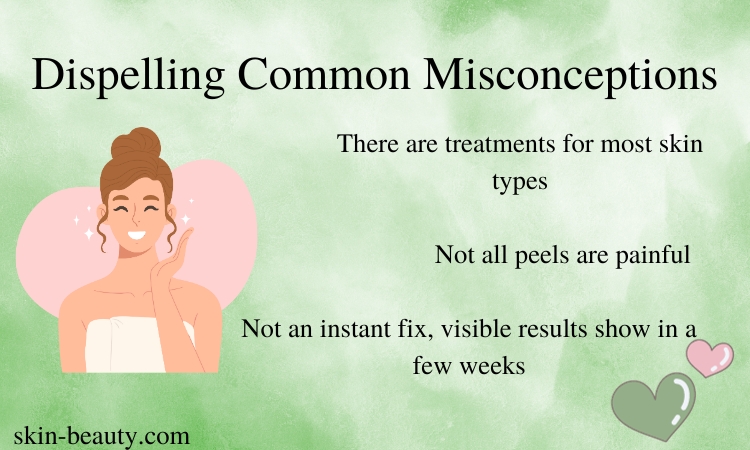
There are several common misconceptions about how chemical peels work that can be dispelled with accurate information. One misconception is that chemical peels are only suitable for certain skin types. In reality, certain skin types, such as those with sensitive skin, rosacea, or eczema, can also benefit from chemical peels.
Another misconception is that chemical peels are always painful and provide instant results. In truth, the intensity of the peel can vary depending on the type of peel and the strength of the solution being used to treat it, so it’s not always a painful experience. Also, while chemical peels can provide visible results in a few weeks, they do not offer an instant fix.
Summary
In conclusion, chemical peels are a versatile and effective cosmetic treatment for a wide range of skin concerns. With various types and depths available, chemical peels can be customized to address specific skin conditions and rejuvenate your skin. By understanding the science behind chemical peels, the different categories, and the importance of choosing the right peel for your skin, you can unlock the door to a radiant, youthful complexion.
Frequently Asked Questions
Are chemical peels good for the skin?
Chemical peels are a great way to remove dead skin cells, promote collagen production, and unclog pores, which makes it an ideal solution for acne scarring. It's definitely good for your healthy skin too!
How long will a chemical peel last?
Light chemical peels typically last from one to two months, with follow-up treatments available to maintain your skin's appearance and health. Medium and deeper chemical peels usually last between two and six months, after which another light or medium peel can be used for upkeep.
What is the downside of chemical peels?
Chemical peels come with some potential risks, including infection or scarring, and can cause temporary or permanent color changes in the skin. People may also experience itching, increased sensitivity, and post-inflammatory hyperpigmentation (PIH).
Is a chemical peel painful?
Chemical peels cause minimal pain and discomfort. The provider will monitor your reaction to ensure you are comfortable throughout the procedure, so you may only experience a slight tingling or tightness in the skin.
What are the benefits of chemical peels?
Chemical peels offer a variety of benefits, such as reducing wrinkles, evening out skin tone, diminishing scars, and improving overall skin texture and appearance, making them an excellent choice for achieving smoother and brighter-looking skin.
Recent Posts
-
Hyaluronic Acid Injections
Hyaluronic Acid Injections: What to Know & Non-Invasive Alternatives That Actually Work In the p …Jun 17th 2025 -
Kojic Acid Creams
My Kojic Acid Journey: How One Ingredient Transformed My Skin (And the Best Kojic Acid Creams to Try …Jun 11th 2025 -
LightStim vs. Omnilux
LightStim vs. Omnilux: My Real LED Skincare Results & Which One I Recommend LED light therapy&nb …Jun 3rd 2025

